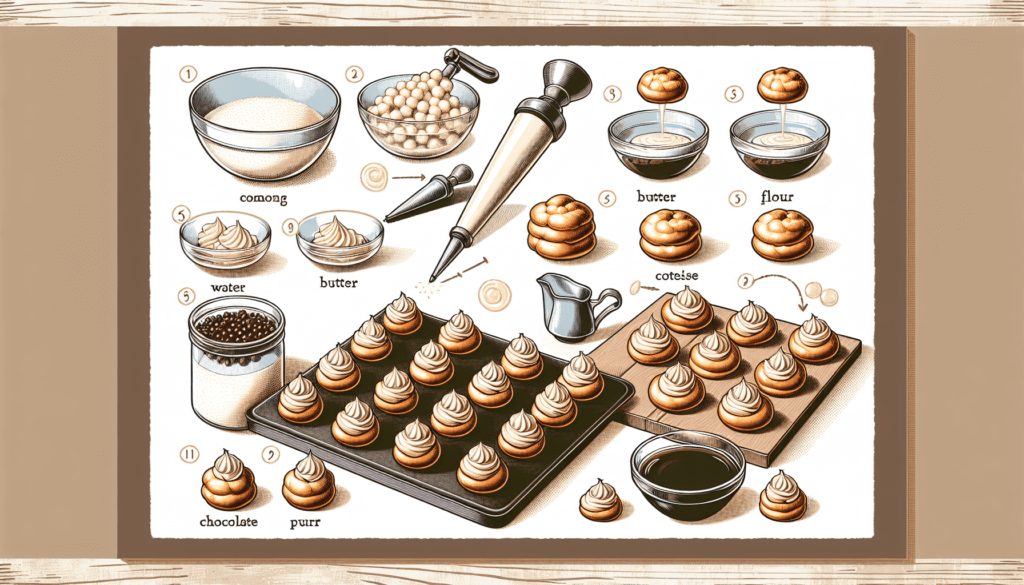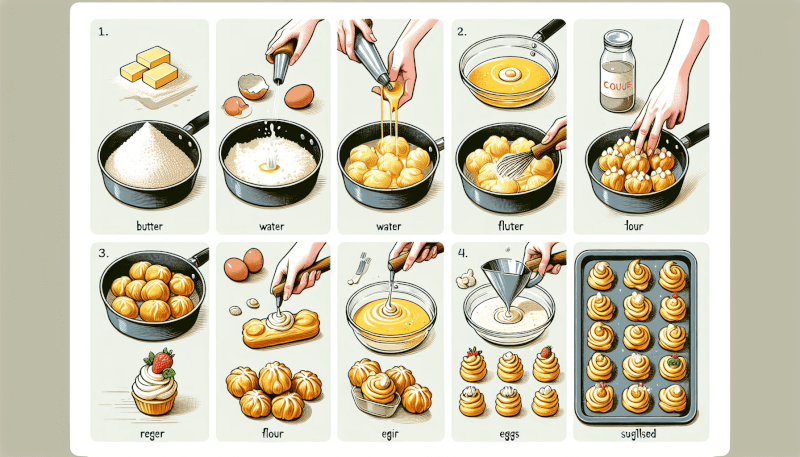Are you craving a sweet and delicate dessert that will truly impress your guests? Look no further than the art of choux pastry and its delightful creations, specifically profiteroles. These bite-sized treats are not only visually stunning but also incredibly delicious. In this article, we will guide you through the process of mastering the art of choux pastry, from the light and airy dough to the creamy and indulgent filling. Get ready to wow your friends and family with your exceptional profiteroles skills!
Understanding Choux Pastry
What is Choux Pastry?
Choux pastry, also known as pâte à choux, is a light and airy pastry dough that is used to create delicious treats such as profiteroles, éclairs, and cream puffs. This versatile dough is made by cooking a mixture of water, butter, and flour on the stovetop before incorporating eggs to create a smooth and glossy dough. When baked, the dough puffs up dramatically, creating a hollow center that is perfect for filling with sweet or savory fillings.
The History of Choux Pastry
Choux pastry has a long and fascinating history that dates back several centuries. It is believed to have been invented in 1540 by a chef named Panterelli during the Renaissance period in Italy. However, it was not until the 17th century that choux pastry gained popularity in France, where it was further developed and refined.
The name “choux” actually means “cabbage” in French, which is a reference to the pastry’s resemblance to small cabbages when baked. Over the years, choux pastry has become a staple of French cuisine and has spread to many other countries around the world, where it is enjoyed in a variety of different forms.
Key Characteristics of Choux Pastry
Choux pastry is unique in its texture and taste. One of its key characteristics is its light and airy texture, which is achieved through the high moisture content in the dough. When the dough is baked, the water in it turns into steam, causing the pastry to puff up. This creates a delicate and hollow shell with a crisp outer layer and a soft, tender interior.
Another characteristic of choux pastry is its versatility. It can be used to create a wide range of pastries, from small bite-sized profiteroles to longer éclairs. Choux pastry also has a neutral flavor, which makes it the perfect canvas for a variety of different fillings and toppings. The dough can be sweetened with sugar or flavored with spices, extracts, or zests to enhance its taste.
Ingredients for Choux Pastry
To make choux pastry, you will need the following ingredients:
Water
Water is the primary liquid used in choux pastry. It is important to measure the water accurately since the amount of liquid affects the consistency of the dough.
Butter
Butter adds richness and flavor to the choux pastry. It is melted in the water before adding the flour.
Flour
Flour is the main dry ingredient in choux pastry. It provides structure and thickness to the dough.
Eggs
Eggs are a crucial component of choux pastry as they contribute to its structure and texture. The eggs are added one at a time, and each addition should be fully incorporated before adding the next.
Salt
Salt helps to balance the flavors in the choux pastry. It is added to the dry ingredients before they are mixed with the wet ingredients.
Optional Flavorings
To add additional flavor to your choux pastry, you can incorporate optional flavorings such as vanilla extract, lemon zest, or spices. These flavorings should be added to the dough along with the eggs.

Mastering the Choux Pastry Technique
To create impressive profiteroles, it is essential to master the technique of making choux pastry. Here are the key steps involved:
Preparation and Organization
Before you start, ensure that you have all the ingredients measured and prepared. Preheat the oven to the required temperature and line a baking sheet with parchment paper.
Cooking the Mixture
In a saucepan, combine the water and butter and bring it to a boil. Reduce the heat and quickly add the flour mixed with salt. Stir vigorously until the dough forms a ball and pulls away from the sides of the pan.
Piping Techniques
Transfer the dough to a piping bag fitted with a large round tip. Pipe the dough onto the prepared baking sheet in the desired shape and size, leaving enough space between each piece to allow for expansion.
Baking and Cooling
Bake the choux pastry in the preheated oven until it is golden brown and crisp on the outside. Once baked, remove from the oven and allow the pastries to cool completely on a wire rack. Cooling the pastries properly ensures that they retain their crispness.
Troubleshooting Common Choux Pastry Problems
While making choux pastry may seem daunting, it is possible to troubleshoot common problems that may arise. Here are some solutions to common issues:
Flat or Deflated Profiteroles
If your profiteroles turn out flat or deflated, it could be due to insufficient moisture in the dough. To prevent this, ensure that you accurately measure the amount of water and butter, and be sure to cook the dough thoroughly before adding the eggs.
Cracked Profiteroles
Cracking can occur if the choux pastry dough is not baked at the correct temperature or if it is under- or over-mixed. Make sure to bake the pastries at the recommended temperature and avoid overmixing the dough.
Dough Too Wet or Too Dry
Achieving the right consistency is crucial for choux pastry. If the dough is too wet, it will not hold its shape during baking. Conversely, if the dough is too dry, it will not expand properly. Adjust the water or flour quantities accordingly to achieve the desired consistency.
Uneven Baking
Uneven baking can be a result of an inconsistent oven temperature or overcrowding the baking sheet. To ensure even baking, preheat the oven properly and bake the choux pastries in batches, leaving enough space between each piece.
Filling Leaking or Soggy
If your filling is leaking or making the profiteroles soggy, it could be due to undercooking the pastries or not allowing them to cool completely before filling. Make sure to bake the pastries until they are crisp and ensure they are completely cooled before adding the filling.

Tips for Flavorful and Beautiful Profiteroles
To take your profiteroles to the next level, consider the following tips:
Enhancing Taste with Flavored Fillings
Experiment with a variety of different fillings to bring a burst of flavor to your profiteroles. Consider using flavored creams, fruit compotes, or even liqueurs to add depth and complexity.
Choosing the Right Shape for Profiteroles
While traditional profiteroles are round and ball-shaped, feel free to get creative with the shape. Consider piping the dough into different shapes such as stars, hearts, or cylinders to add visual interest to your desserts.
Decorating Techniques
Add an extra touch of elegance to your profiteroles by decorating them with various techniques. You can drizzle them with melted chocolate, dust them with powdered sugar, or even glaze them with a glossy icing.
Adding Texture and Crunch
To add a delightful contrast in texture, consider incorporating crunchy elements such as chopped nuts, toffee, or caramelized sugar on top of your profiteroles. This will provide a satisfying crunch alongside the soft pastry and creamy filling.
Variations on Classic Profiteroles
While classic profiteroles are always a crowd-pleaser, don’t be afraid to experiment with different flavors and fillings. Here are some exciting variations to try:
Chocolate Profiteroles
For all the chocolate lovers out there, consider dipping your profiteroles in melted chocolate or filling them with a rich chocolate cream. The combination of the delicate pastry and the indulgent chocolate creates a heavenly treat.
Coffee Profiteroles
Add a delicious twist to your profiteroles with a hint of coffee. Incorporate espresso powder or coffee extract into the dough or filling for a delightful mocha flavor.
Fruit-Filled Profiteroles
For a fresher and lighter option, fill your profiteroles with fresh fruits such as berries or sliced peaches. The natural sweetness of the fruits complements the pastry perfectly.
Savory Options
Profiteroles don’t always have to be sweet! Consider filling them with savory fillings such as herbed cream cheese, smoked salmon, or chicken salad for a delightful appetizer or snack.

Perfecting the Profiterole Filling
The filling is an essential component of profiteroles, and getting it just right is crucial. Here are some options for delicious fillings:
Classic Crème Pâtissière
The most traditional filling for profiteroles is crème pâtissière, a creamy vanilla custard made with milk, eggs, sugar, and vanilla beans. This smooth and silky filling pairs perfectly with the light pastry.
Other Delicious Fillings
If you’re looking to explore beyond the classic crème pâtissière, consider fillings such as whipped cream, chocolate ganache, fruit curds, or even flavored mousses. The choice of filling depends on your personal preference and the flavor profile you want to achieve.
Injecting or Filling Profiteroles
To fill your profiteroles, you can either cut them in half and pipe the filling onto the bottom half, or you can use a pastry bag fitted with a small tip to inject the filling directly into the shell through a small hole.
Storing and Serving Profiteroles
To keep your profiteroles fresh and delicious, follow these tips:
Proper Storage Techniques
After filling, store the profiteroles in an airtight container in the refrigerator. This will help maintain their freshness and prevent them from becoming stale.
Reheating and Refreshing
If your profiteroles lose their crispness, you can reheat them in the oven for a few minutes at a low temperature to regain their texture. Make sure not to overheat them, as they can quickly become too soft.
Serving Suggestions
Profiteroles are delightful on their own, but they can also be served with various accompaniments to create an impressive dessert. Consider serving them with a drizzle of warm chocolate sauce, a dusting of powdered sugar, or a scoop of vanilla ice cream.

Common Mistakes to Avoid
To ensure success in making choux pastry, watch out for these common mistakes:
Overcooking the Pastry
Overcooking the pastry can lead to dry and hard profiteroles. Make sure to follow the recommended baking time and keep a close eye on the pastries as they bake.
Insufficient Water Evaporation
Proper water evaporation is crucial for achieving maximum puffiness. Cook the dough for long enough to allow the excess water to evaporate, ensuring a light and airy texture.
Incorrect Egg Incorporation
Adding the eggs too quickly or not fully incorporating them into the dough can result in a weak and flat pastry. Take your time when adding the eggs, making sure each one is fully mixed in before adding the next.
Ignoring Resting Time
Resting the dough after cooking and before adding the eggs allows the excess heat to escape, preventing the eggs from cooking too quickly. Be patient and give the dough enough time to cool down before proceeding.
Inadequate Oven Temperature
Baking choux pastry at too low of a temperature can result in pastries that do not puff up properly. Make sure to preheat your oven to the recommended temperature and maintain it throughout the baking process.
Mastering Choux Pastry for Impressive Profiteroles
Mastering the art of choux pastry takes practice and patience. Don’t be discouraged if your first attempts are not perfect. With time, you will develop a feel for the dough and learn how to make adjustments to achieve the desired results.
Experimentation is also key to perfecting your choux pastry skills. Don’t be afraid to try new techniques, flavor combinations, and decorations. The more you practice and explore, the better your profiteroles will become.
Remember to balance textures and flavors when creating your profiteroles. The delicate and crisp pastry should be complemented by the creamy and flavorful filling. Take the time to think about the combinations that work well together, and don’t be afraid to get creative with different fillings, flavors, and textures.
Finally, when presenting your profiteroles, take the time to arrange them beautifully. Consider serving them on a platter, garnished with fresh berries or a dusting of powdered sugar. Pay attention to the small details, and your impressive profiteroles will leave a lasting impression on anyone lucky enough to enjoy them.



